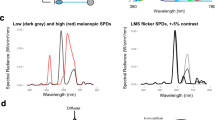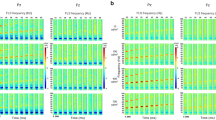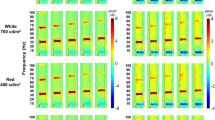Abstract
IT follows from the data of Schaternikoff, Fedorov and Fedorova1, R. Lithgoe and K. Tansley2, and others, that during dark adaptation the critical flicker frequency for photopic vision is decreased. It has been shown by Alexanian and Livshiz in Orbeli's laboratory (Leningrad) that the same is the case in scotopic vision provided the effect produced by the change of threshold sensitivity during dark adaptation is eliminated. Critical frequency was therefore always determined for a light intensity which was a multiple of the threshold at the given moment. In the course of light adaptation the critical frequency is, on the contrary, increasing (R. Lithgoe and K. Tansley). The purpose of the present study was to analyse the causes underlying the above change of critical flicker frequency in the course of dark and light adaptation. Both dark and light adaptation were therefore studied by means of a special optical device which afforded the possibility of watching in a homogeneously illuminated field (angular size about 10°) the flickering of a central point visible within an angle of 1°, the brightness of which was equal to that of the background.
This is a preview of subscription content, access via your institution
Access options
Subscribe to this journal
Receive 51 print issues and online access
$199.00 per year
only $3.90 per issue
Buy this article
- Purchase on Springer Link
- Instant access to full article PDF
Prices may be subject to local taxes which are calculated during checkout
Similar content being viewed by others
References
Fedorov, N., and Fedorova, V., Z. Phys., 57, 855 (1929).
Lithgoe, R., and Tansley, K., Med. Res. Council, Spec. Report Series, No. 137 (1929).
Barcroft, J., "Features in the Architecture of Physiological Function" (1935).
Ives, H., J. Opt. Soc. Amer., 27, 107 (1934).
Houstoun, R. A., "Vision and Colour Vision" (London, 1932).
Granit, R., (a) "Die Elektrophysiologie der Netzhaut und des Schnerven, Copenhagen", 1936 (Ada Ophth. Suppl. VIII); and (b) "The Physiological Significance of the Retinal Synapses" (Report of a Joint Discussion on Vision, 263–271; 1932).
Author information
Authors and Affiliations
Rights and permissions
About this article
Cite this article
FEDOROV, N., MKRTICHEVA, L. Mechanism of Light Flicker Fusion during the Course of Dark and Light Adaptation. Nature 142, 750–751 (1938). https://doi.org/10.1038/142750a0
Issue Date:
DOI: https://doi.org/10.1038/142750a0
Comments
By submitting a comment you agree to abide by our Terms and Community Guidelines. If you find something abusive or that does not comply with our terms or guidelines please flag it as inappropriate.



